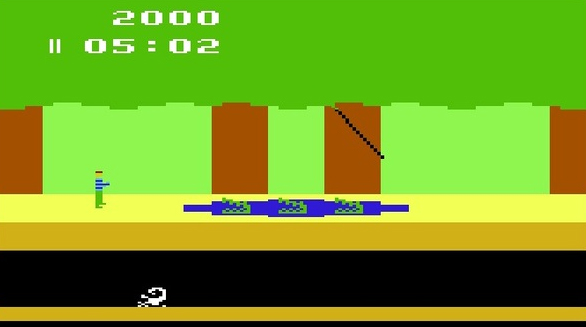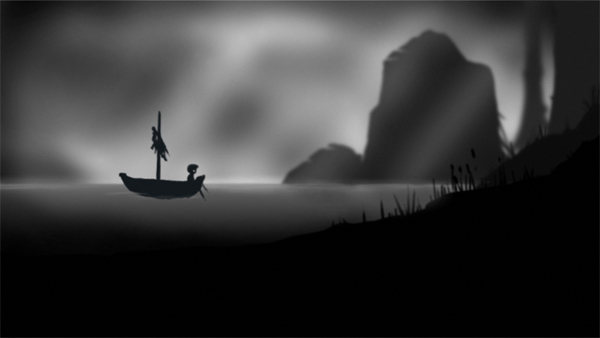Photorealistic graphics. Motion tracking. Character expression rendering. Virtual reality. Heck, even The Matrix doesn’t seem so far-fetched these days. In a culture of bigger, better, faster, more, it’s all too easy to forget that less can be more, too. And if developers are doing all of the heavy lifting, artistically speaking, what’s left for the audience to do?
Of course, all video games by nature draw to some degree on the player’s imagination. Even the most mind-numbing shoot-‘em-ups ask the player to fancy the enemies they’re mowing down as more than just a product of complex code, and the simplest of puzzle games still require a bit of creative critical thinking to solve. If they didn’t involve at least a modicum of resourcefulness on the part of the player, they wouldn’t be games. They would be movies.
As many a quotable quote will tell you, however, imagination is a muscle; it needs to be exercised, or it will atrophy. Many of the gamers of today will become the programmers of tomorrow; forgive the mixed metaphor, but if they forget how to flex that muscle and use it to discover the next step, the techno-train of progress is inevitably going to run out of steam.

Is making art purely for art’s sake – more specifically, better graphics for graphics’ sake – a shallow waste of time? Of course not. Pushing the technical envelope is kind of our (humanity’s) thing, and I stand in perfectly genuine awe of what we continue to accomplish on a daily basis. But going forward, those who reside in the world of game development need to take a step back now and then from all those beautiful concept art sketches and elaborate 3D maps and models and remember that audience participation – beyond button-mashing and problem solving – is half the game. Legos are fun because they don’t come preassembled; likewise, gaming is at its finest when gamers are given room to do what they do best and play with the digital material they are given.
Travel back in time with me, for a moment, to 1982, the year of the Commodore 64, the Elk Cloner, and – more relevantly – a certain Atari 2600 game by the name of Pitfall! Though aesthetically unimpressive by today’s standards, Pitfall! sold over four million copies, and many a player today still remembers the trials and terrors encountered while scrambling to recover treasure in the jungle. Objectively, the game is little more than a timed race to get a stick figure past a bunch of obstacles that look like they were drawn in Paint; it is only in the player’s mind that those weird little green things at the bottom of the screen are transformed into deadly, man-eating crocodiles, and black blobs are transformed into bottomless pits of doom.
The best of modern retro-styled games play on that very same quality. Lone Survivor, though a bit more graphically sophisticated than Pitfall!, uses the visual impact of purposefully low-quality graphics to its advantage. The monsters and environments become exponentially scarier because the player’s imagination is given room to go to town on the particulars, projecting the worst of their nightmares onto the screen. Similarly, Hotline Miami offers the monsters in all of us buckets of blood and mass murders galore, but all the real gory details are still left up to players to superimpose onto the game’s walking chalk outlines and cartoonish, Argento-red blood splatters.

On the opposite end of the graphics spectrum, modern “art” games and “experimental” games have similar potential for firing up gamers’ neurons. Gorgeous enough to satisfy a generation pampered by the likes of Skyrim and Bioshock Infinite, games in the art and experimental genres could easily be played by a lazy audience at face value as a simple, relatively quick way to pass the time. Their real value, however, lies in their unique take on imaginative gaming, which often features ambiguous plots and symbolism that invites, even insists, on deeper analysis.
Journey, Limbo, and Dear Esther, to name just a few, look and feel vastly different from one another, with one commonality: not one of them gives the player a direct explanation as to what is going on, or why any of it is happening. Even Dear Esther, despite featuring extensive narration, steadfastly remains vague and open to interpretation, refusing to push any one specific reason or objective onto the player. The significance of everything, from the tiniest of details to the entire purpose of the experience, is limited only by the player’s ingenuity.

Visual novels, meanwhile, are more like interactive paintings, generally with rather attractive casts of characters set against beautifully drawn backdrops. Though a few may include short animated sequences and some degree of sound – voice acting, music, and sometimes, as in the case of sakevisual’s chilling [text] A Summer Story, a few well-placed sound effects – VNs primarily dwell in the realm of two-dimensional static imagery, which changes every so often at a click of the mouse, the way panels in a comic book shift to a new scene once the page is turned. The player is given the perspective of an audience member at a puppet show, only able to see scenery and characters from a fixed point; the rest, including most if not all of the action, is filled in mentally, using whatever optical hints are available.
In fact, most of the information garnered in visual novels is found not in the graphics but in dialog, both internal and external, which is again often left up to the player to analyze and interpret. A protagonist’s thoughts will often read (or be read by a voice actor) like a scrolling marquee, a continual and often quite telling sort of color commentary, and the majority of player-NPC interactions will involve navigating a conversation tree. Indeed, VNs rely on dialog-based gameplay so heavily that it has often been debated whether they qualify as video games at all.

But if visual novels don’t qualify as video games, neither do MUDs or interactive fiction – a statement which would likely spark a rage in more than one seasoned fan of either (or both), myself included. Such text-based adventures are the epitome of imaginative gaming. Though only a few crucial steps removed from choose-your-own-adventure books, they are in fact the purest form of what gaming is really all about: interactive storytelling. The author provides a skeleton, with bones of words and ASCII art; the body is then formed and shaped by the gamer’s individual experience as he or she plays.
Colossal Cave Adventure, also known as simply Adventure or ADVENT, was released in 1976 as the first computer adventure game. In the very first paragraph, developer William Crowther acknowledges the inevitable, indirect creative collaboration between creator and consumer: “I will be your eyes and hands. Direct me with commands of 1 or 2 words. (Errors, suggestions, complaints to Crowther.)” The player cannot see the world in the developer’s mind that the game is based on, but the developer can describe that world in detail and allow the player to construct a comparable, though never exact, image of that world in their own mind.
Similarly, the perceived danger in an interactive fiction horror story like Anchorhead or All Alone, just as it would be in an actual novel, is purely text-based and psychological, with no visual stimulus (i.e. cheap jump-scares) to help trick the reader into a state of fear. Even the most elaborate ASCII landscape, like that of Dwarf Fortress, is still just a glorified version of alphabet soup until the player’s imagination reorders it into something more significant.

This, of course, is the mark of true art: it becomes greater than the sum of its parts. Returning to the Lego analogy for a moment, to a child, a house of Legos isn’t just a toy model of a house: it’s a home for a blocky little Lego family, a shelter from make-believe hardships. To a gamer, a video game isn’t just a neat trick of light and sound and code, something to pass the time: it’s an adventure, a journey of mind and spirit. That is the core of imaginative gaming. A decent game will offer up a good story, or at least a good time; a great game will become a great story, something uniquely personal to be shared over drinks with friends or in hushed tones late one dark and stormy night ‘round a digital campfire in the forums. And, in the words of Neil Gaiman, “We owe it to each other to tell stories.”

 …WOOLY DESERVES BETTER LOL!
…WOOLY DESERVES BETTER LOL!